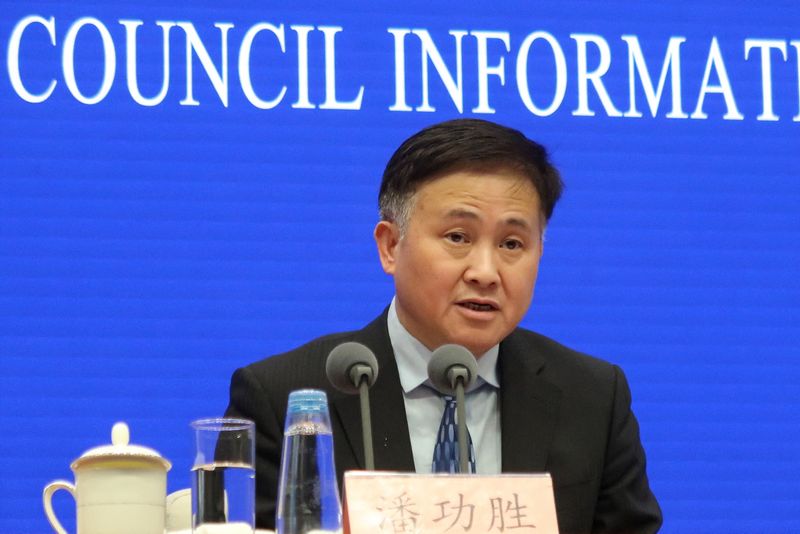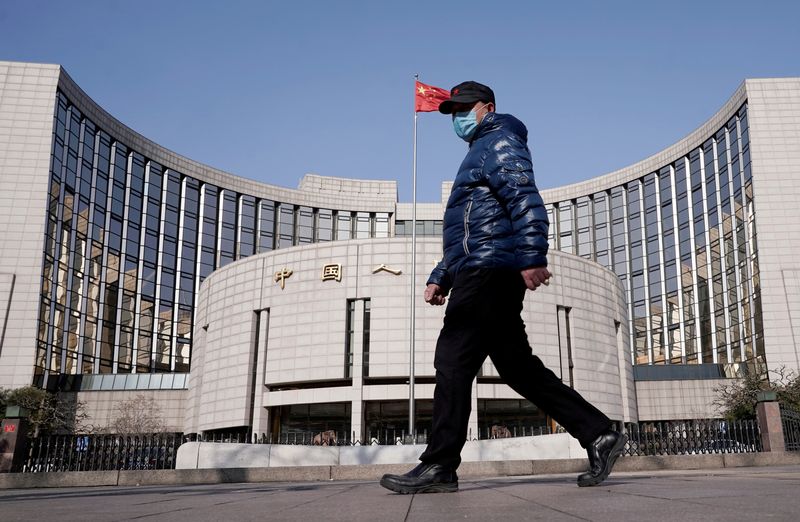(Reuters) - China's central bank will cut the amount of cash that banks must hold as reserves from Feb. 5, governor Pan Gongsheng said on Wednesday, the first such cut for the year as policymakers extend efforts to shore up a fragile economic recovery.
The People's Bank of China (PBOC) would cut the reserve requirement ratio (RRR) for all banks by 50 basis points (bps), thereby freeing up 1 trillion yuan ($139.45 billion) to the market.
Chinese blue-chip stocks, which hit five-year lows earlier this week, bounced 1.8% on the day. Hong Kong's benchmark index soared by 3.6%, having endured its most volatile start to the year since 2020 and after plunging on Monday to 15-month lows.
The yuan hit its highest since Jan. 12. On the offshore market, the yuan held mostly steady against the dollar at 7.168.
COMMENTS:
SAKTIANDI SUPAAT, REGIONAL HEAD OF FX RESEARCH AND STRATEGY, MAYBANK, SINGAPORE:
"It's in some ways, in line with expectations... the aim is actually to increase liquidity so that banks can lend more to customers and take a bit more risk and buy more bonds to support economic growth.
Beyond this, I think they need to do a bit more to do 'animal spirits', and animal spirits is (one of) probably a robust economy, a feeling of improving wealth effects, the function of equity being more robust... so I think more needs to be done."
REMI OLU-PITAN, HEAD OF MULTI-ASSET GROWTH AND INCOME, SCHRODERS, LONDON:
"We think that it’s a step in the right direction, but more is needed."
"In our opinion, the incentive to reduce exposure is pretty powerful and so we think this provides a pause, but we’re worried that any recovery will be an opportunity to de-risk."
"We need more powerful forces. Two powerful forces are, one, maybe more transparency in terms of the direction of regulation and policy…an additional support actually will come from the U.S. in terms of the Fed - a cutting cycle provides liquidity not just to the U.S. market but externally and typically that comes from a weaker dollar. And with liquidity you get animal spirits."
GARY NG, SENIOR ECONOMIST FOR ASIA PACIFIC, NATIXIS, HONG KONG:
"The RRR cut is what the economy needs, and the recent weakened sentiment may have just brought the timing forward. It offers the certainty that the government is willing to stabilise the economy, but it is also unlikely to be a fully lax monetary policy mode. Consumption and real estate data after the Spring Festival will be critical for any anticipation of further easing."
FRANCES CHEUNG, RATES STRATEGIST, OCBC BANK, SINGAPORE:
"The cut has been well anticipated, but the market was unsure about the exact timing. The long-term liquidity can facilitate banks to extend loans, or - in an environment where loan demand may be weak, the liquidity released can support bond issuances thereby fiscal stimulus."
"It underlines our medium-term upward bias to yuan rates and CGB (Chinese government bond) yields as markets shall ultimately respond to the better growth outlook resulting from various support measures, and if bond supply is coming through."
"We maintain a 10-year CGB yield expectation at 2.70-2.80% by year-end."
SAMY CHAAR, CHIEF ECONOMIST, LOMBARD ODIER, GENEVA:
"It's part of the toolbox where they are taking incremental steps basically to put a floor under economic activity and potentially financial markets."
"We're still very, far from any kind of decisive policy intervention to really change the economic direction of the country. Rather, it's a continuation of the small steps we've seen."
"It does put a floor under Chinese growth, and certainly allows some form of stability."
KIYONG SEONG, LEAD ASIA MACRO STRATEGIST, SOCIETE GENERALE, HONG KONG:
"The scale of 50-bps cut is larger than expected, but the timing of a cut before the Lunar New Year might not be a big surprise to some extent, especially after a stock market rescue plan announcement earlier. Furthermore, another policy announcement for property developers will be out soon, as the PBOC hinted."
"We would like to wait to see a full set of policy supports before concluding the impact on the overall market."
KELVIN WONG, SENIOR MARKET ANALYST, OANDA, SINGAPORE:
"In the short-term, it will be a positive for Chinese equities, but in the medium-to-long-term, it's difficult to say if it will have a significant impact on the economy."
"The only way to see more positive flows back into the stock market is to have some new stimulus that directly boosts confidence among consumers."
ALVIN TAN, HEAD OF ASIA FX STRATEGY, RBC CAPITAL MARKETS, SINGAPORE:
"It’s worth bearing in mind that this’ll be the third cut in a year. It'll be more than the previous ones, which were 25 bps each. But it's just injecting more liquidity in the system and it does seem that there's a growing lack of demand and consumption. The economic situation is poor so people aren’t in any urgency to borrow money."
"I think the more important thing is yesterday's news about the stock market rescue package, so that might be a reason to keep downside pressure on dollar/renminbi", (because it would reportedly involve off-shore funds buying Chinese stocks through Hong Kong, likely involving selling dollars for yuan).
KEN CHEUNG, CHIEF ASIAN FX STRATEGIST AT MIZUHO BANK
"The RRR cut wasn't too unexpected to me."
"I think the purpose of the RRR cut is meant to lift the stock markets before the Lunar New Year holidays. And the PBOC also announced other supportive measures."
"The RRR cut could free up some funds that will be needed before the holiday. Its side effect on the yuan won't be huge."
TIM GRAF, HEAD OF EMEA MACRO STRATEGY AT STATE STREET, LONDON:
"My initial thoughts are that this is a little bit overdue as we have expected more easing to support the economy."
"Along with some of the stimulus announced yesterday, it does seem like they (the authorities) are paying more attention to stimulus that can support growth and markets."
"But the challenges are still there and the banking system is still in trouble."
"This is not entirely unexpected and this is not the panacea that will change the narrative too much. More targeted stimulus would be a more powerful lever to push and they seem to reluctant to do that."
KHOON GOH, HEAD OF ASIA RESEARCH, ANZ, SINGAPORE:
"It's probably not surprising. Markets and ourselves have been calling for RRR cuts to happen given that the economic recovery has been pretty weak, and I guess the timing is not unexpected, especially coming after the news yesterday about some kind of rescue plan for the stock market. In terms of market reaction, I think the equity market obviously has taken the news fairly positively, so the rally managed to continue."
CHRISTOPHER WONG, CURRENCY STRATEGIST, OCBC, SINGAPORE:
"Markets have been expecting the RRR cut for a while so the announcement is not entirely a surprise. That said, policymakers should ride on the positive momentum by announcing some form of support measures for the economy targeting consumption. This, alongside the 1 trillion liquidity injection (RRR) and potential support for the equity market can help rebuild credibility and shore up investor confidence."
CHRIS SCICLUNA, HEAD OF ECONOMIC RESEARCH, DAIWA CAPITAL MARKETS, LONDON:
"It’s one of the usual tricks the authorities resort to when they want to provide some support, whether to the markets or to the economy as a whole. It’s arguably a more effective tool than a rate cut in China, given that we’re in this environment of excess capacity in so many sectors and the ongoing structural and cyclical adjustments."

"It’s a welcome step, but it’s not going to be game-changer. There are still questions about the extent to which the National Team, and various institutions can try to pull together to try to support the market and start up the buying of stocks and draw a line under the sell-off there."
"But there are obvious question marks as to the extent to which that can turn around the market or not. It’s clear this isn’t any speculative pressure against the market that is causing the rout. It’s a reflection of the trend going forward."
